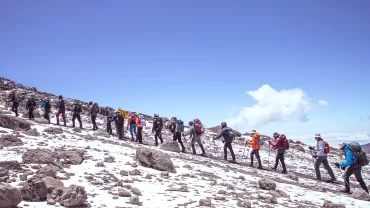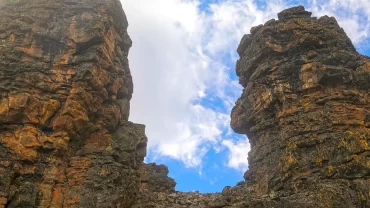The Ultimate Kilimanjaro Experience with Stunning Scenery
1. Introduction to the Lemosho Route
The Lemosho Route is widely considered the most beautiful and well-balanced route on Mount Kilimanjaro (5,895m / 19,341 ft). Known for its stunning landscapes, great acclimatization profile, and high summit success rate, this trail offers an unforgettable Kilimanjaro experience.
Unlike the Marangu Route, which is shorter but less scenic, or the Machame Route, which is steeper, the Lemosho Route provides a longer, more gradual ascent, allowing trekkers to better acclimatize. This makes it one of the best routes for climbers looking to maximize their chances of reaching Uhuru Peak.
2. Key Facts About the Lemosho Route
- Distance: ~70 km (43 miles)
- Duration: 7-8 days
- Difficulty Level: Moderate to Challenging
- Scenery: Rainforest, moorland, alpine desert, glaciated summit
- Acclimatization Profile: Excellent – gradual ascent with “Climb High, Sleep Low” opportunities
- Success Rate: ~90% for 8-day trek, ~85% for 7-day trek
- Accommodation Type: Camping (no huts available)
- Best Time to Climb: January-March & June-October
3. Route Overview & Highlights
The Lemosho Route starts on the western side of Kilimanjaro, offering a remote and less crowded beginning before merging with the Machame Route at Shira Camp. Trekkers pass through a variety of ecological zones, including dense rainforests, rolling moorlands, high-altitude deserts, and glaciated peaks.
Highlights of the Lemosho Route:
✅ Best scenery on Kilimanjaro – breathtaking landscapes throughout the trek.
✅ Great acclimatization profile – gradual ascent increases summit success.
✅ Low traffic at the start – fewer crowds compared to Machame and Marangu.
✅ High success rate – among the best routes for reaching Uhuru Peak.
4. Who Should Choose the Lemosho Route?
✅ Best for:
- Trekkers who want a scenic and immersive Kilimanjaro experience.
- Those who prefer a longer climb with better acclimatization.
- Climbers looking for a high summit success rate.
❌ Avoid if:
- You want hut accommodations (opt for Marangu instead).
- You have limited time (shorter options like Machame or Rongai may be better).
- You prefer a very quiet climb (Northern Circuit is more remote).
5. Pros & Cons of the Lemosho Route
✅ Pros:
- One of the most scenic routes – diverse landscapes and stunning viewpoints.
- Excellent acclimatization profile – gradual ascent reduces altitude sickness risk.
- Higher summit success rate (~90%) compared to shorter routes.
- Less crowded at the start – avoids heavy traffic on early days.
❌ Cons:
- Longer duration (7-8 days) – requires more time and endurance.
- More expensive due to additional days and logistical support.
- Camping only – no hut accommodations available.
6. Acclimatization & Success Rate
The Lemosho Route is one of the best routes for acclimatization, thanks to its gradual ascent and strategic “Climb High, Sleep Low” approach. This minimizes the risk of Acute Mountain Sickness (AMS) and significantly increases summit success rates.
- 8-day itinerary success rate: ~90%
- 7-day itinerary success rate: ~85%
- Why? More days allow for better adaptation to altitude, improving overall summit chances.
7. Challenges & Difficulty Level
The Lemosho Route is rated moderate to challenging, but it remains one of the most manageable routes for those with good fitness levels.
Key Challenges:
- Longer trekking days – requires endurance and stamina.
- High-altitude exposure – summit night is physically and mentally demanding.
- Steep sections – the Barranco Wall presents a scrambling challenge.
Preparation Tip: Train with cardio, strength, and endurance exercises to ensure you’re ready for the long trek.
8. Best Time to Hike the Lemosho Route
The best months for climbing Kilimanjaro via the Lemosho Route are:
- January to March: Cooler temperatures, fewer climbers, and beautiful summit conditions.
- June to October: Peak climbing season with dry weather, but more crowded trails.
Avoid: April-May & November (rainy seasons, making trails slippery and visibility poor).
9. Packing & Preparation Tips
Since the Lemosho Route covers diverse climates, packing the right gear is crucial.
Essential Packing Items:
- Layered Clothing: Includes base layers, insulated jackets, and a waterproof outer shell.
- Trekking Poles: Essential for stability on steep sections like the Barranco Wall.
- Hydration System: CamelBak or water bottles to stay hydrated.
- Sleeping Bag: Rated for -10°C (14°F) or colder.
- Headlamp & Extra Batteries: Required for early morning summit attempt.
For a detailed packing guide, check out The Ultimate Tanzania Adventure Packing List.
10. Comparing the Lemosho Route with Other Kilimanjaro Routes
| Route | Difficulty | Duration | Success Rate | Accommodation | Crowds |
| Lemosho | Moderate | 7-8 days | ~90% | Camping | Medium |
| Machame | Moderate-Challenging | 6-7 days | ~85% | Camping | High |
| Marangu | Moderate | 5-6 days | ~50-60% | Huts | High |
| Rongai | Moderate | 6-7 days | ~80% | Camping | Low |
| Northern Circuit | Longest & Easiest | 9+ days | ~95% | Camping | Very Low |
If you want the best acclimatization and highest success rate, Lemosho and Northern Circuit are top choices. If you want a shorter trek, Machame or Rongai may be better options.
11. Final Thoughts: Is Lemosho the Right Route for You?
The Lemosho Route is perfect for climbers seeking a scenic, well-paced, and highly successful Kilimanjaro trek. With its low traffic at the start, excellent acclimatization, and breathtaking views, it’s an ideal choice for those who want a rewarding and immersive journey to Uhuru Peak.
Are you ready to conquer Kilimanjaro via the Lemosho Route? Start planning your adventure today!
For more insights, check out How to Choose the Best Kilimanjaro Route.





Comment (0)